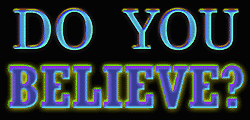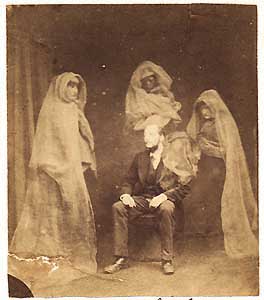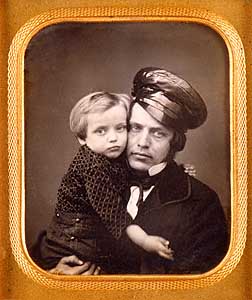A Final Thought on Spirit Photography
A Final Thought on Spirit Photography


A Final Thought on Spirit Photography
|
Perhaps it is only a coincidence that the last major spirit photographer was a man named Hope. And yet hope is what Spiritualism is all about. Look at the faces of the believers in the spirit photographs (as opposed to the mediums themselves) and you see ordinary people with an extraordinary need to hope in the survival of the spirit after death. This need, born of deep emotional pain, led the great magician Harry Houdini into “the realm of the spirits,” searching in vain for a single honest medium who could put him in touch with his departed mother. Houdini never found what he was looking for, although perhaps he himself never gave up hope.
Many spirit photographers prided themselves on “recognition,” the production of a picture in which a specific person’s spirit could appear with sufficient likeness to the deceased that friends and relatives would recognize the features of the person portrayed. Many tricks were employed– the French spirit photographer Buguet was caught with a series of dummies and 299 photographs of the heads of men, women and children. But at his trial patrons rose to his defense, insisting that Buguet had photographed their departed relatives exactly. Often the use of stock head shots was obfuscated beneath a concealing haze of “ectoplasm” or through blurry focus and chemical stains. No matter–believers believed, and recognized the faces they longed to see again.
Today, it is difficult to comprehend the power of belief and suggestion and hope that could turn a double-exposure of a dummy in a sheet into a miraculous message from the afterlife. Many of these images are crudely done, and convey nothing of the spiritual force or personality that we associate with a living, breathing human being.
 |
But take a moment to compare these two photographs. To the left, an English spirit photograph made in the studio of Frederick Hudson, and purporting to show four ghosts. Even on close examination there is nothing distinctive about these spirits that sets them apart, and it is difficult to imagine how one of them could have been “recognized” as the mother of one of the people involved.
|
Now look at this daguerreotype–taken around 1854, perhaps twenty years before the spirit photograph. The only documentation is the names pencilled on a piece of paper found with the image: “Uncle Geo. & Gus.” But from this early portrait, we feel we know something about these people and the bond between them. Many who have viewed this picture have said they feel the personalities of Uncle George and Gus were captured by the daguerreotypist, to be shared with us a century and a half later.
|
 |
And so it is possible to receive messages sent by those who have been dead for many years. And it is possible to feel their presence and to sense they are still with us in some way. But for that to happen, we require no person with supernormal powers to put us in contact with another plane of existence, and there needs to be no seance in a darkened room.
Instead of a spirit medium, it is the medium of photography itself that has within it this remarkable, mystical power.
Wm. B. Becker
|
Book & Video Recommendations |||| Leave a Comment
Copyright © 2000 The American Photography Museum, Inc. All Rights Reserved. “American Museum of Photography” and the logo are Service Marks of The American Photography Museum, Inc.


